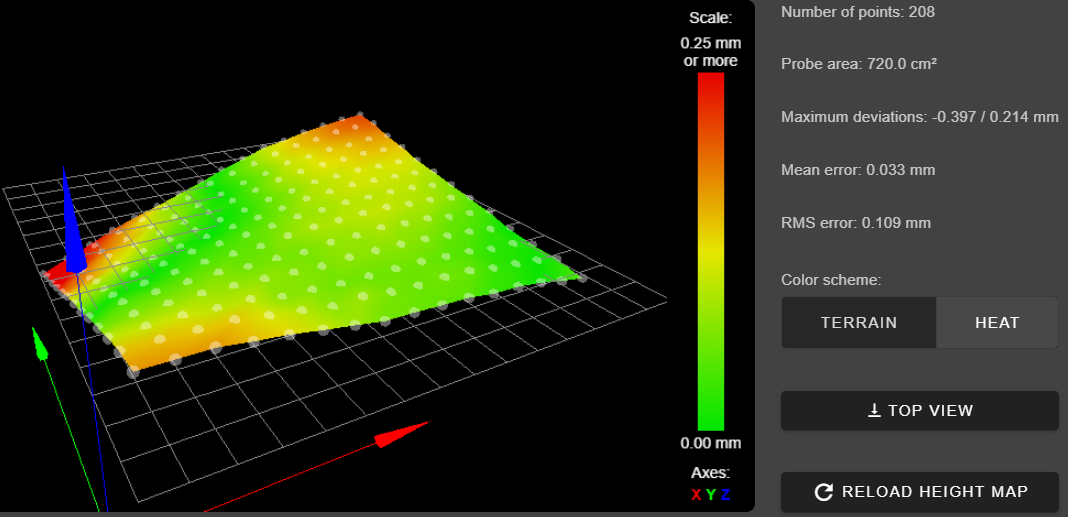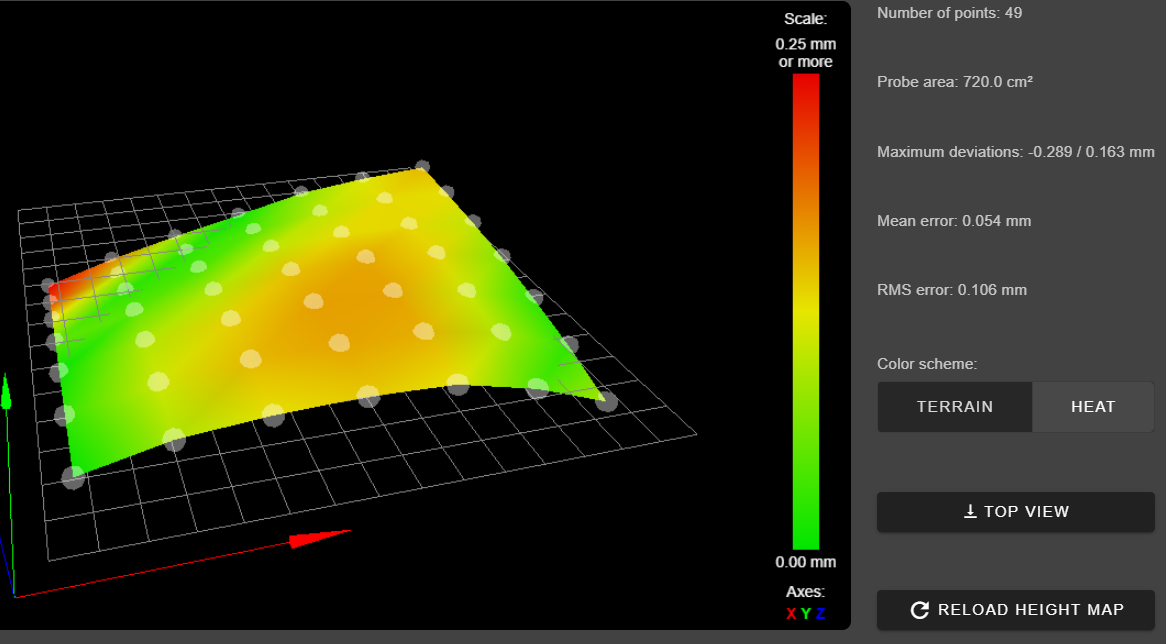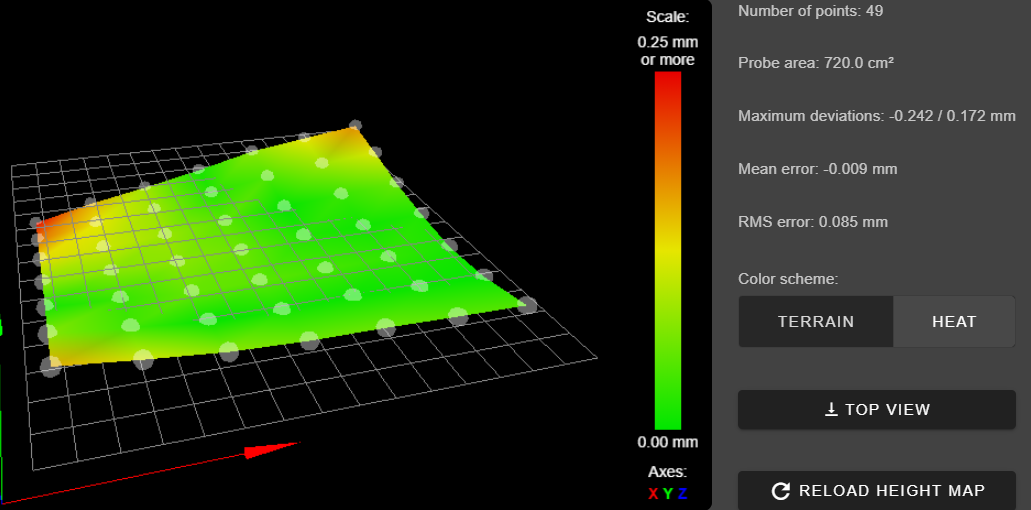Bed mesh - 1st test after installed rails
-
@whopping-pochard said in Bed mesh - 1st test after installed rails:
ot being completely parallel, inducing a twist in your X axis towards the back of your bed. If you have a known flat surface, like a good straight edge or carpenter's square, you could try rocking it diagonally across your glass bed. You should be able to pick up .75 mm of twist visually if it is the bed.
I am pretty sure the rails are all lined up properly, as it is very easy to move the Y and X axis. I moved everything around pretty well (checking and rechecking for any binding) as I tightened down all the screws.
That is a good idea. I have a similar tool to a carpenter's square (actually it could be a carpenter's square , need to get the tool out) I used to put in the floor in my basement to make straight cuts.
, need to get the tool out) I used to put in the floor in my basement to make straight cuts.
Thank you for that idea and will have to look at that later... -
I forgot about removing the clips as I put them there to try and resolve issues a while back that ended up being worn wheels on the Z axis. As they have been replaced with rails in the last week+, I should remove them and at least try it out.
I do have another mount that will move the BLTouch further away from the fan I can try out. Printed it a few days ago.
When everything is working perfectly, I have seen the BLTouch give me accuracy of .00X during a auto bed level. After a print, power on/off, it can change to around .02x to .05x. Not always easy to get it back to that level of accuracy. Generally after 3 auto bed attempts, if it doesn't give me .00x, it will not and I just print anyways. Later I can try it and it may be on point again. I printed new hotend parts with this current hotend/printer rail setup to see if I can get more consistent readings and will install them this weekend. The current hotend parts were printed on the previous build using worn out wheels, and why I wanted the upgrade.... tired of changing wheels, and warn wheels ruining parts, and making filament monitor pointless other then to save plastic, as I wasn't able to resume to the same Z location... I have never bothered to use my caliper on this printer because I put it together to use a 3 point auto bed level.
My issue is, that because my BLTouch can give me better then 50 microns in repeatability, and everything with the carriage is super tight. The entire printer moves a tad when I push the hotend or bed, I am assuming something else is physically off with the print to make the first layer squish not consistent over the bed. And that is without using bed level compensation, only auto bed level. I only ran bed level compensation to see if there was really a measurable problem that I was seeing on the first layer and there seems to be by the mesh picture.I auto bed leveled again, and reran the mesh covering as much of the bed as possible (this new setup gives me more X space, and the BLTouch is in a different location and it changed up how much is can measure in Y).

-
I have a 4mm bed plate I have yet to use... I put it on top of the glass, and it isn't able to get less then .1xx mm variance...
Mesh

Flipped it over, and checked mesh again.

Going to let it cool, and heat up. Then going to run mesh again on this metal plate.
Curious to see if the bowls again, facing up or down. (metal causes the direction, or it goes away from the heat). -
How is your bed attached? You're using 3-point leveling, but is the bed itself attached to a frame that's connected to independent Z axes by four screws? If so it's possible that the bed is twisted via the attachment to the frame. Were you able to find straightedge to check that visually?
If it's not that, still possible that your rails are ever so slightly out of parallel. Depending on the other mechanics, in particular the torsional rigidity of the X axis, it's completely possible to have smooth travel if the rails have a slight twist with respect to one another. You could loosen the screws and shim one end to evaluate.
-
You are correct and I had forgotten to reply. The bed is attached to a frame and the frame is attached to the 3 motor/screws for auto bed leveling. The mounting method seems to not be easy to get perfect and, I am guessing because of the heat/cool cycling isn't consistent. After noticing this, I tweaked it so it is better, but many times I find the back to be lower then the front (not as much of a twist) and other times I still see a twist. It seems as if I do auto bed leveling and then auto bed compensation, it's "good enough" to not be a problem. I have seen some people with my printer remove the frame all together, and not sure what parts I would need or if I could even get their method working with my setup. (Heated bed may be to big etc...). But it is something to look into.
Thanks for the feedback!
-
Which printer design is it? I've got a BLV cube I'm working on adding a 3-point kinematic bed to.

-
@whopping-pochard
Yes. That is what I want to do!
I have a RatRig V-Core, I upgraded to a v2 last year and just upgraded it to a Pro. So it looks very close to what you have in the picture.I have a Keenevo heated pad on the back of a 3mm steel bed, with glass on top. I have a 4mm bed I am not yet sure how I will use (replace the 3mm or just put on top). Also have a magnetic printing surface I would like to use but I don't yet know how I want to use the bed/glass to permanently attach the magnetic to the glass or metal just yet....
Saying that, Keenevo suggests you sandwich the heated pad between two sheets of metal... Not sure if I would want to do this just yet because of how I need a flush top to the entire bed (glass reaches corner to corner) and would need bevel our screw hole and currently only have 3 (or 4) mm to work with.If you have any prototype versions your working on already another public design I should look at. I wouldn't mind printing parts and trying it out.
-
Sweet! I'm remixing from this mod: https://www.thingiverse.com/thing:4163121
I'm changing the parts to print better without support and to incorporate some additional features, like emergency endstop switches on each Z. I'm also changing the bed design -- the remix I'm basing from uses the frame-and-bed system, which does give you bed leveling but, as you know, doesn't really take advantage of the kinematic restraint. So I'm using a Railcore aluminum bed as the bed structure, and securely attaching each of the three mount points to a short piece of 2020 to act as a thermal barrier to the printed support. Each support has a different magnetic mount coupled to a magnetic ball, allowing for 3-, 4-, and 5-axis movement, respectively.
Hope it works.

-
@whopping-pochard
All of the Amazon links don't seem to work. Where did you get all the parts? -
I happened to have some of the rectangular magnets, but I just searched for the large countersunk and disc magnets to fit the dimensions of the parts.
Having tried them out, though, I've decided to redesign those parts around different magnets. With the magballs you're not taking advantage of most of the flux in those really large flat magnets (the holding power for the big flat one is really poor), and there's no reason to have so much available travel—a 350 mm aluminum plate should expand ~ 0.5 mm. So I'm redesigning those parts around 1/4" thick x 3/4" diameter magnets from kjmagnetics.com.
-
@whopping-pochard
I recently put a thick thermal (heat sink) pad under the glass, and it helping.
I still want to remove that frame and attach the 4mm bed directly to the rails... so still interested in your progress.
-
@BlueDust wow! That is a flat bed! Nice!
I’ll keep you posted! Waiting on a few more parts to come in before I can assemble everything and see how it works.